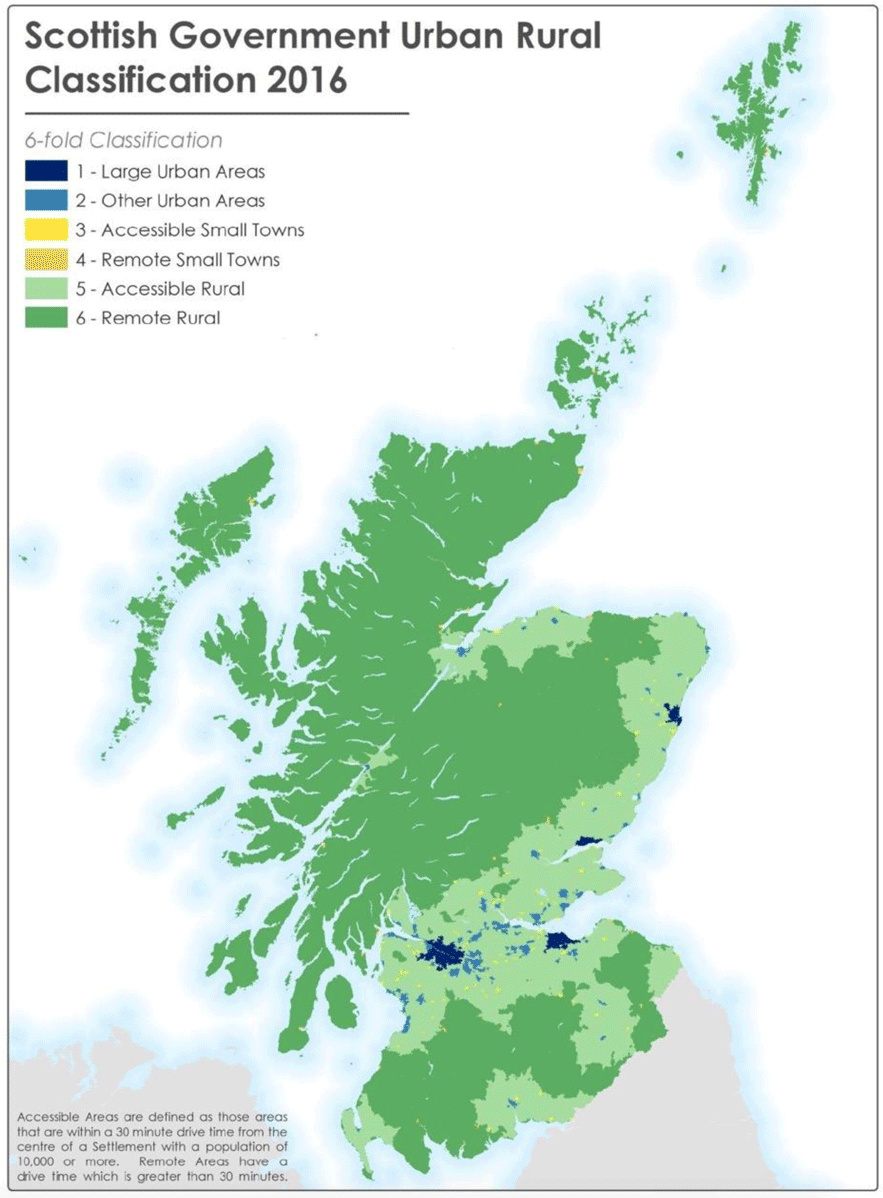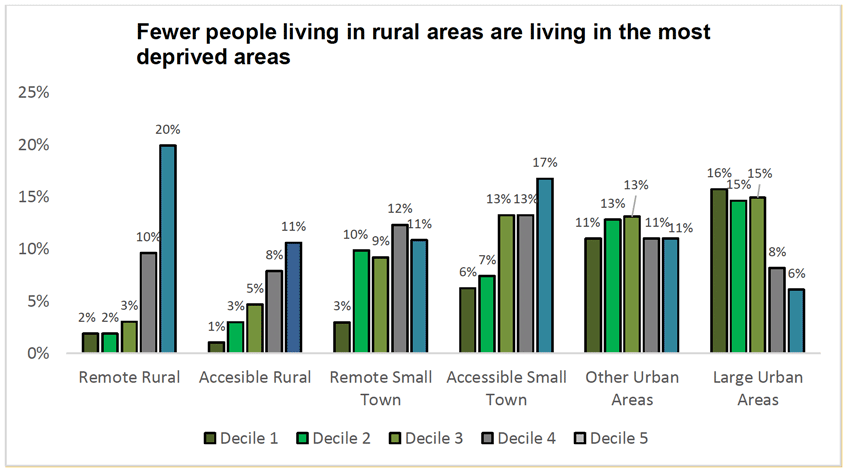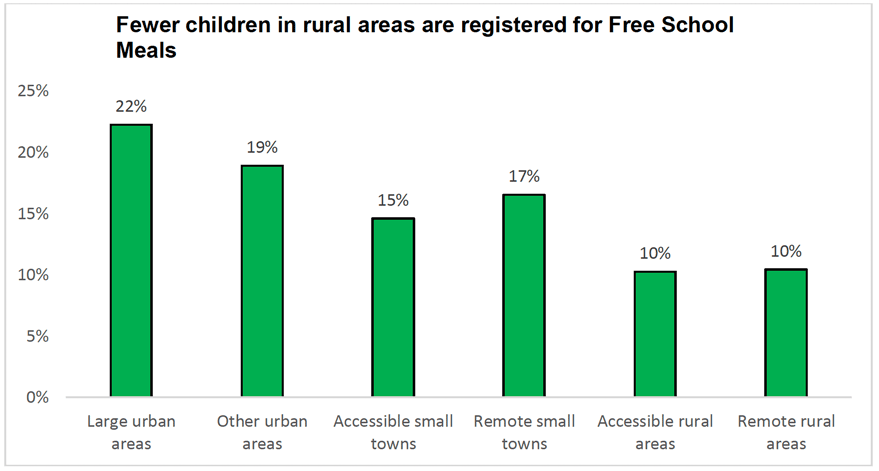Poverty in rural Scotland: evidence review
This report reviews current evidence and research on rural poverty in Scotland
2. Rural poverty in Scotland
Summary:
- 15% of people in rural areas are living in relative poverty and 11% are living in severe poverty.
- Just 2% of people living in remote rural areas, 1% of people living in accessible rural areas and 3% of people living in remote small towns live in Scotland's most deprived areas.
- 19% of children living in rural areas are living in relative poverty.
- 12% of children in accessible rural areas and 13% of children in remote rural areas are living in families with limited resources.
- Fewer pupils in accessible rural and remote rural areas are registered for Free School Meals than in urban areas.
- These indicators of poverty have been criticised for failing to take into account the dispersed nature of rural poverty and the cost of living in rural Scotland.
People in Scotland are typically considered to be living in poverty if their income is below 60% of the UK median income. They may also be said to be experiencing multiple deprivations – that is, a lack of resources and opportunities. Poverty has often been considered an urban issue given that poverty and deprivation are more concentrated in these areas. Rural poverty, thus, tends to be harder to identify in the most commonly used poverty measures which focus on income and areas of deprivation.
Just over 5.4 million people live in Scotland, with over 930,000 of them living in rural areas (Scottish Government, 2021b). The Scottish Government's two-fold Urban-Rural classification (Scottish Government, 2016), defines rural areas as settlements of less than 3,000 people, though there are many other definitions of rurality which complicate the picture. Our most commonly used classification is the 6-fold classification, shown in the table 3 below. Within this rural category, there may be important differences between places closer to, or further from, urban centres, particularly in relation to employment opportunities, transport and cost of living.
This report aims to look beyond the income and deprivation measures which are commonly used to measure poverty and will review the current evidence on rural poverty in Scotland.
| 1 Large Urban Areas | Settlements of 125,000 or more people. |
|---|---|
| 2 Other Urban Areas | Settlements of 10,000 to 124,999 people. |
| 3 Accessible Small Towns | Settlements of 3,000 to 9,999 people and within 30 minutes drive of a settlement of 10,000 or more. |
| 4 Remote Small Towns | Settlements of 3,000 to 9,999 people and with a drive time of over 30 minutes to a settlement of 10,000 or more. |
| 5 Accessible Rural | Areas with a population of less than 3,000 people, and within a 30 minute drive time of a settlement of 10,000 or more. |
| 6 Remote Rural | Areas with a population of less than 3,000 people, and with a drive time of over 30 minutes to a settlement of 10,000 or more. |

2.1 How many people in rural Scotland are in poverty?
Research indicates that rural areas have lower poverty rates than urban areas. As can be seen in Table 2, 15% of people (170,000) in rural areas were living in relative poverty in the period between 2016/17 and 2018/19, compared to 20% (850,000) of people living in urban areas. A further 11% (130,000) of the rural population were living in severe poverty, compared to 15% (600,000) of the urban population. Nevertheless, the number of people in severe poverty has grown more rapidly between 2006/17-2008/09 and 2016/17-2018/19 in rural areas (increased by 30% in rural areas compared to 11% in urban areas).
|
|
2006/07 - 2008/09 | 2007/08 - 2009/10 | 2008/09 - 2010/11 | 2009/10 - 2011/12 | 2010/11 - 2012/13 | 2011/12 - 2013/14 | 2012/13 - 2014/15 | 2013/14 - 2015/16 | 2014/15 - 2016/17 | 2015/16 - 2017/18 | 2016/17 - 2018/19 |
|---|---|---|---|---|---|---|---|---|---|---|---|
| People in relative poverty AHC (below 60% of UK median income) | |||||||||||
| All people | 19% | 19% | 18% | 18% | 18% | 18% | 18% | 19% | 19% | 20% | 19% |
| Urban | 20% | 20% | 19% | 18% | 19% | 19% | 20% | 20% | 20% | 21% | 20% |
| Rural | 15% | 14% | 14% | 14% | 14% | 13% | 13% | 14% | 14% | 15% | 15% |
| People in severe poverty AHC (below 50% of UK median income) | |||||||||||
| All people | 13% | 13% | 12% | 12% | 12% | 12% | 13% | 13% | 13% | 14% | 14% |
| Urban | 14% | 14% | 13% | 12% | 12% | 13% | 13% | 14% | 14% | 15% | 14% |
| Rural | 9% | 10% | 9% | 9% | 9% | 9% | 9% | 9% | 10% | 11% | 11% |
Source: Poverty and income inequality statistics, Scottish Government (2020a)
This data uses low income poverty measures. That is, people are said to be living in poverty if their income is below a certain level. The critique of income based measures is twofold. Firstly, 'they measure resources which a household has, not the standard of living which it achieves' (Bailey et al. 2016, 6). Secondly, they do not take into account differences in the cost of living across Scotland and may, therefore, paint a misleading picture of poverty (Bailey et al. 2016). As is discussed in section 4, the cost of living is often higher in rural areas and disposable income will not, therefore, go as far.
An alternative measure of poverty is deprivation. Measures of deprivation differ from measures of income in that they measure standards of living. Deprivation can be considered the outcome of a lack of income and other resources, such as housing, household amenities, education and healthcare. The Scottish Government measures deprivation using the Scottish Index of Multiple Deprivation (SIMD). The SIMD identifies small geographic areas where there are high concentrations of individuals who are experiencing low income and multiple forms of disadvantage. It currently measures seven separate domains: income, employment, health, crime, housing and access to services.
Figure 1 shows the percentage of the population living in SIMD deciles 1-5 (where ten is the least deprived and one is the most deprived) by the Scottish Governments 6 fold Urban Rural Classification (Scottish Government, 2016).
The most deprived communities are not evenly spread across Scotland. Just 2% of all people living in remote rural areas, 1% of people living in accessible rural areas and 3% of all people living in remote small towns live in the most deprived decile. In comparison, 6% of all people living in accessible small towns, 11% of all people living in other urban areas and 16% all people living in large urban areas live in the most deprived decile.

Source: Scottish Index of Multiple Deprivation 2020, Scottish Government (2020b) (using the Scottish Government Urban Rural Classification)
This indicates that fewer people living in rural areas are living in the most deprived areas. The SIMD has, however, been criticised from a rural perspective. As Bailey et al. (2016, 6) point out, 'place-based measures of deprivation…tend to fail to identify the localised pockets of poverty in rural areas, which are both dispersed (unlike poverty which may be concentrated on urban housing estates for example) and interspersed amongst pockets of wealth'. Rural areas infrequently feature, therefore, in lists of most deprived areas.
2.2 How many children in rural Scotland are in poverty?
Data shows that rural populations also have lower child poverty rates than urban areas. As can be seen in Table 3, 19% of children living in rural areas were living in relative poverty in the period between 2017-2020, compared to 26% of children living in urban areas. This figure has increased from 16% in the period between 2016-19.
| Children in relative poverty AHC (below 60% of UK median income) (2017-2020) | ||
|---|---|---|
| Urban | Rural | All |
| 26% | 19% | 24% |
Source: Poverty and child poverty data, Scottish Government (2021a)
Again, these figures use low income poverty measures which do not take into account wider deprivation measures.
2.3 Limited Resources
Another way of measuring child poverty is by looking at data of children in Scotland living in families that have "limited resources". The limited resources measure looks at children in families that have both low income and cannot afford three or more out of a list of 22 basic necessities. The list of necessities includes having: a damp-free home; money to cover unexpected expenses and repairs; money to save regularly; enough money to take part in sport and leisure activities; and money to take a holiday away from home at least once a year. Families are defined as being on a low income if the household income is below 70% of the Scottish median income after housing costs (Scottish Government, 2017).
Table 5 shows the percentage of children living in families with limited resources by the Scottish Governments 3 fold Urban Rural Classification (Scottish Government, 2016). The 3 fold classification is set out in Table 4.
| 1 Rest of Scotland | Settlements of 3,000 or more people |
|---|---|
| 2 Accessible Rural | Areas with a population of less than 3,000 people and within 30 minutes drive of a settlement of 10,000 or more. |
| 3 Remote Rural | Areas with a population of less than 3,000 people and with a drive time of over 30 minutes to a settlement of 10,000 or more. |
Table 5 shows that fewer children are living in families with limited resources in rural areas than in urban areas. Indeed, 12% of children in accessible rural areas and 13% of children in remote rural areas are living in families with limited resources, after housing costs, compared to 20% in urban areas. This again suggests that child poverty is lower in rural Scotland.
| Before housing costs % | After housing costs % | |
|---|---|---|
| Accessible rural | 13.9 | 12.3 |
| Remote rural | 15.8 | 13.6 |
| Urban | 23.1 | 20.4 |
| All areas | 20.4 | 18.0 |
Source: Scottish Government (2019b)
2.4 Free School Meals
The number of pupils eligible for free school meals is often used as a proxy for identifying levels of poverty and deprivation within the school setting. This is because, generally, schools in which more pupils are registered for free school meals are situated in areas with higher levels of poverty and deprivation.
Figure 2 shows that fewer pupils in accessible rural and remote rural areas are registered for Free School Meals than in urban areas. Although this indicates that there are lower levels of poverty and deprivation in rural areas, using free school meal entitlement as a measure of deprivation has been criticised. Research by the Child Poverty Action Group (2020) argued that at least two in five school age-children who live below the UK's poverty line are not entitled to free school meals. This equates to 45,000 children in Scotland. The research suggests that the strict income thresholds for eligibility mean that many families do not receive support, in particular those living in in-work poverty.

Source: September 2020 Pupil Census[1], Scottish Government (2021d) (using the Scottish Government Urban Rural Classification)
Contact
Email: socialresearch@gov.scot
There is a problem
Thanks for your feedback